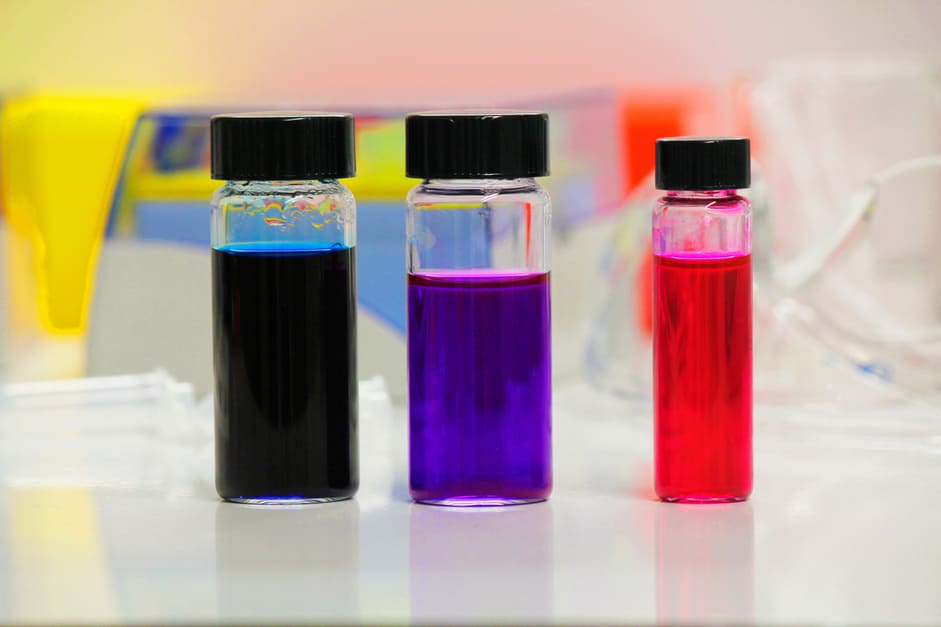Quenchers are a substance that can decrease or end an effect or process. They are often used to absorb the excitation energy emitted by fluorophores (i.e., fluorescence), which signals that another process has taken place. Most re-emit much of the energy as visible light. Others, called dark quenchers, do not have native fluorescence and instead emit the energy as heat. Examples of common quenchers include iodide ions, molecular oxygen and acrylamide..
How do quenchers work?
Fluorescence is a type of luminescence where a photon is produced using energy released from the absorption of a photon with a higher energy level.
In one common type of fluorescent quenching, the quencher absorbs the fluorophore’s energy when it is close to it, which suppresses its emission. Quenchers can re-emit some of that energy, either as heat or light. When the quencher and the fluorophore are separated, the quencher can’t absorb the fluorophore’s energy, which allows the fluorophore to fluoresce and be detected again. These properties make quenchers useful across a wide range of biochemical applications.
Types of quenching
A variety of methods can bring about quenching. Any process that decreases or ends the fluorescence intensity of a sample falls under the umbrella of fluorescence quenching. There are two main types of quenching: static and dynamic.
Static quenching
In static quenching, also known as contact quenching, an intramolecular dimer is formed between the quencher and a ‘reporter’ fluorophore. This creates a non-fluorescent ground-state (un-excited) complex, formed before excitation occurs. The complex has a unique absorption spectrum. Disruption of quenching via hydrolysis of the probe causes a signal to be released from the fluorophore. The fluorophore and quencher must be in contact for both dynamic and static quenching to occur.
Dynamic quenching
In dynamic quenching, the interaction between the quencher and an excited state fluorophore results in the return of the fluorophore to its ground state. In dynamic quenching, electron excitation occurs before quenching. The efficiency of dynamic quenching is dependent on the concentration of the quencher. Increasing the temperature also increases the rate of dynamic quenching.
Applications of quenchers
Fluorescence quenching has been studied both as a phenomenon and as a pathway to understanding biochemical systems. Applications of quenchers include:
Probes for Genetic Analysis
Fluorescent probes labeled with both a fluorophore and a quencher (dual-labeled probes) have a range of applications in genetic analysis, such as product detection in quantitative-PCR (qPCR).
The efficiency of fluorescence quenching is dependent on distance between the fluorophore and quencher. If they are far apart, fluorescence occurs. If they are close together, fluorescence is suppressed or ended.
Oligonucleotide probes, such as TaqMan or Molecular Beacon probes, are widely used for diagnostic purposes. These probes incorporate a quencher and fluorophore pair that have overlapping absorption and fluorescence emission spectra. The oligonucleotide acts as a flexible tether linking the fluorescent reporter and quencher. The probe is designed to keep the quencher and fluorophore close to each other in the absence of a target molecule, and separate when the target is present. A fluorescent signal therefore indicates that the target molecule is present and therefore signal the event being monitored (such as hybridization or nuclease activity).
Another example of these probes are FAM-TAMRA probes: oligonucleotide probes with fluorescein (FAM) as a 5' label and tetramethyl rhodamine (TAMRA) as a 3' label. Here, FAM is the reporter dye and TAMRA is the acceptor dye (or quencher). There is a good spectral overlap between the FAM fluorescence emission and TAMRA absorption curves.
However, when a fluorescent dye such as TAMRA is used as a quencher, its fluorescence can contribute to background signal. Using a fluorescent quencher also makes multiplexing (where more than one fluorophore-quencher pair is used in a reaction simultaneously) more difficult. Dabcyl is an alternative quencher that combats some of these issues, as it is a dark quencher and is therefore not fluorescent.
FRET assays
FRET (Förster Resonance Energy Transfer) quenching is a type of dynamic quenching in which energy from the fluorescent donor or reporter dye is transferred to the quencher without the absorption or emission of light. FRET probes contain the donor and quencher close to each other. In a FRET assay, the donor dye is excited and transfers energy to the quencher. After the donor dye absorbs light, the donor’s fluorescence is absorbed by the quencher. The fluorescence is then emitted at the quencher’s emission wavelength. The signal is therefore a fluorescence emission at a longer wavelength than if the quencher weren’t present.
FRET- systems are useful for measuring intra- and inter-molecular distances at very high resolution (1-10 nm). For example, FRET oligo probes have been used to measure and distinguish between individual ribosomes programmed with different mRNAs.
Coupling proteins to magnetic beads
Magnetic beads can be functionalized with a huge range of substances, including NHS esters (succinimidyl esters). Quenching can be used to ensure that no free NHS groups remain on the magnetic beads when they are used again in future assays.
Magnetic particles as quenchers
Magnetic beads themselves can also be used as fluorescence quenchers. For example, for the detection of thrombin as part of clinical diagnosis by taking advantage of the binding affinity between a fluorescent aptamer (a short sequence of DNA or RNA that binds to a specific molecule). Quenching occurs when the fluorescent aptamer is absorbed on the surface of the magnetic nanoparticles in a binding solution, via an interaction between the aptamer’s phosphate backbone and the magnetic particle’s hydroxyl groups.
Find out more about quenching
Quenching has many applications in healthcare, such as the molecular diagnosis of S. aureus, where quenchers are a key part of the detection process that involves a silica nanoparticle-oligonucleotide conjugate.
Quenching can also occur while you are carrying out other processes – sometimes undesirably. For bioimaging, conjugated polymer nanoparticles (CPN) produce higher intensity fluorescence than most dyes and are far less susceptible to quenching. Find out more in our article on synthesis of fluorescent nanoparticles for bioimaging.
Related news





